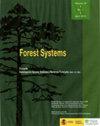Forest canopy gaps offer a window into the future The case of subtropical coastal forests within an urban matrix in South Africa
IF 0.7
4区 农林科学
Q3 FORESTRY
引用次数: 1
Abstract
Aim of the study: Alien and indigenous species emergence patterns within canopy gaps in urban subtropical forests are poorly understood. This study compared canopy gap floristics in relation to abiotic and physical characteristics across three subtropical urban forests differing in disturbance history.Area of study: Three Northern Coastal Forests of varying disturbance histories found in coastal subtropical urban KwaZulu-Natal (KZN), South Africa (SA).Materials and methods: Closed canopy ( n = 15 quadrats per forest ) and four gaps from three size classes (‘small’ < 25 m2, ‘medium’ 25 - 45 m2; ‘large’ > 45 m2) were surveyed for each forest using classical vegetation sampling techniques. Soil moisture content and air temperature were measured within each gap.Main results: Cumulatively all forests hosted 198 species. Species richness was highest in the primary highly disturbed forest followed by the primary least disturbed forest and lowest in the transitional highly disturbed forest. Alien taxa cover within gaps was correlated with higher indigenous seedling emergence in the primary forests. Species richness was positively correlated with gap size and soil moisture content, and negatively correlated with air temperature.Research highlights: Gap floristic patterns are influenced by size, abiotic factors, disturbance and forest successional status. Alien taxa may facilitate indigenous seedling emergence within gaps in primary forests. Floristic, abiotic and physical characteristics of canopy gaps should be monitored within urban forests as they can influence gap infilling regarding species composition and rate. This can inform management strategies including species reintroduction and enrichment planting.森林冠层间隙为未来提供了一扇窗。南非城市矩阵中的亚热带沿海森林案例
研究目的:对亚热带城市森林林冠间隙内外来和本地物种的出现模式了解甚少。本文比较了三种不同干扰历史的亚热带城市森林的林隙区系与非生物和物理特性的关系。研究范围:在南非夸祖鲁-纳塔尔省(KZN)沿海亚热带城市发现的三种不同扰动历史的北部沿海森林。材料和方法:封闭的冠层(每片森林15个样方)和三个大小类别(“小”< 25 m2,“中”25 - 45 m2;使用传统的植被采样技术对每个森林进行了“大”(约45平方米)的调查。测定每个间隙内的土壤含水量和气温。主要结果:各森林共有物种198种。物种丰富度以原始高度扰动林最高,其次为原始最小扰动林,过渡性高度扰动林最低。林隙内外来类群的覆盖与原生林较高的本土苗木出苗率相关。物种丰富度与林隙大小和土壤含水量正相关,与气温负相关。研究重点:林隙区系格局受大小、非生物因子、干扰和森林演替状况的影响。外来分类群可能促进原生苗木在原始林林隙内的萌发。城市林冠林隙的植物区系、非生物和物理特征会影响林隙的物种组成和填充率,因此应进行监测。这可以为包括物种重新引入和富集种植在内的管理策略提供信息。
本文章由计算机程序翻译,如有差异,请以英文原文为准。
求助全文
约1分钟内获得全文
求助全文
来源期刊

Forest Systems
FORESTRY-
CiteScore
1.40
自引率
14.30%
发文量
30
审稿时长
6-12 weeks
期刊介绍:
Forest Systems is an international peer-reviewed journal. The main aim of Forest Systems is to integrate multidisciplinary research with forest management in complex systems with different social and ecological background
 求助内容:
求助内容: 应助结果提醒方式:
应助结果提醒方式:


